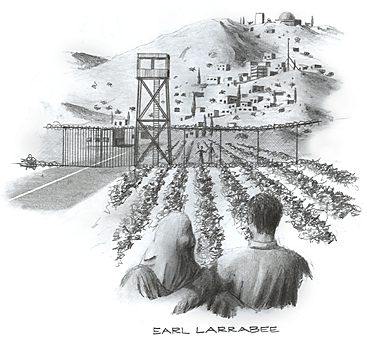
Illustration by Earl Larrabee
|
|
By Matt Stone
Arizona Daily Wildcat
Wednesday, July 13, 2005
Print this
In 1989, the euphoria, optimism, and hope that flooded the streets of Berlin was palpable, as the world’s (ostensibly) last great wall fell – the Cold War won, not only by the West, but also by the frustrated and denigrated people of eastern Europe. It was a triumph of humanity over militarism, hope over fear.
And while we may wax romantic about those revolutionary years, it became evident in the 1990s that walls were meant to be torn down and not erected: free trade became the mantra of the day with the North American Free Trade Agreement (NAFTA) and the formation of the World trade Organization (WTO); divisions between the people of Northern Ireland were pushed dramatically towards the obsolete; and, aside from the world’s abhorrent ignorance towards the tragedy of Rwanda, a theoretical global consensus was forged regarding the inhumanity of genocide everywhere. Indeed, walls were being torn down. People were meant to be a community – or so it seemed.
That is what makes Israel’s “security barrier” today so obscene.
To many Israelis, the 390-mile barrier dividing Israel-proper and the West Bank is a legitimate defense from Palestinian suicide-bombers. To the Israeli government, it is a “temporary” security barrier that will be removed when necessary. To the Palestinians, it is a gross violation of their national and human rights.
Israel’s Wall (which consists of barbed-wire fences, concrete walls, and trenches) officially bites off just 7 percent of the West Bank, not including East Jerusalem, which Israel claims as its own. But the toll on the meager Palestinian way of life is tragic.
In Kfar Qaddum, a small Palestinian town, the Wall blocks the road to Nablus because that road runs through Kedumim, an Israeli settlement. According to “The Economist,” in April of this year, three people died on their way to the Nablus hospital, waiting in an ambulance stopped at a gate through the barrier.
The cost of public transport into Nablus has increased to 25 shekels ($5.70) instead of five. Instead of commuting, Palestinian students now choose to rent rooms in the city, but as tradition frowns upon unmarried women living away from home, women are now studying far less than before.
More dismayingly, the “security barrier” is cutting many Palestinians off from their fields, their primary source of income. Indeed, many have chosen to let their fields lie fallow, as crossing the barrier daily is distressing and time-consuming. In an accident of history, Israel still uses an old Ottoman statute that allows the government to confiscate any land unworked for three years, further fueling Palestinian frustration that the Wall is doing more than just drawing the borders of a future Palestinian state – it is an all-out land-grab.
The International Court of Justice agrees. In July 2004, the ICJ declared the barrier illegal under international law, calling for the dismantling of any parts that encroach on the West Bank and reparations for Palestinians whose rights have been “gravely” infringed. Israeli Prime Minister Ariel Sharon promptly announced he would ignore the ruling.
However, Israel’s own High Court also announced in July 2004 that three-fourths of a 40-kilometer stretch northwest of Jerusalem must be rerouted due to its “severe” effects on the Palestinians living in its path. Israel rerouted slightly, but the underlying injustices inherent in the Wall remain unaddressed.
On Sunday, for the first time, Israel acknowledged that its Wall would cut off some 55,000 Palestinians from Jerusalem, separating them from their schools, hospitals, and jobs. Does this all seem vaguely reminiscent of the ghettos Israel once escaped from?
Israel could justifiably construct a “security barrier” if it followed the Green Line demarcated after the 1967 war. As it stands, the State Department still holds the view that Israeli settlements in Gaza and the West Bank represent “occupation,” and the Wall remains a gross reminder of this. As Israel continues to plod down its destructive path, grievances and frustrations continue to amass within the Palestinian population and throughout the Arab world. The Wall is a short-term solution to a long-term problem, and such a short-term solution only adds to the gravity and difficulty of a future resolution to this conflict.
But, just as importantly, America should be asking for an outcry from its own leadership – Israel’s best friend in the world. Where is our latter-day Ronald Reagan proclaiming, “Mr. Gorbachev, tear down this wall!”? Would President Bush have the cojones to say such a thing? In the War on Terror, while a war between moderation and fundamentalism rages within Islam, our own national security might well depend on it.
The West won the Cold War not because it had friends on one side of the Wall. The West won because it had friends on both sides of the Wall.
Matt Stone is an international studies and economics junior with a penchant for tearing down walls in his own house. He can be reached at letters@wildcat.arizona.edu.
